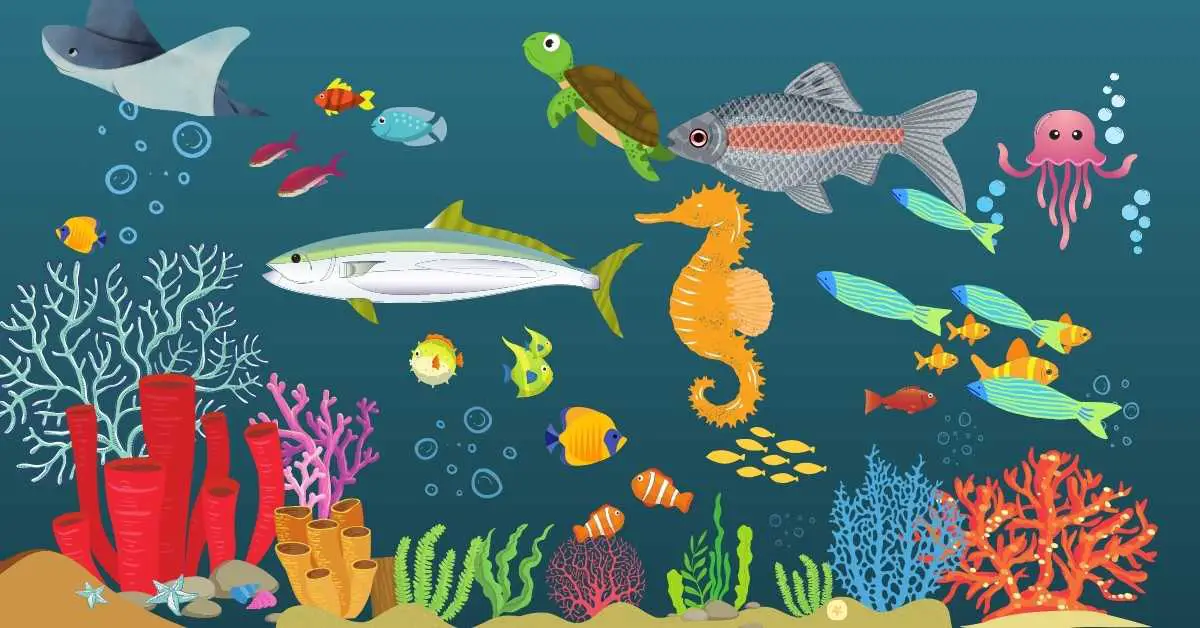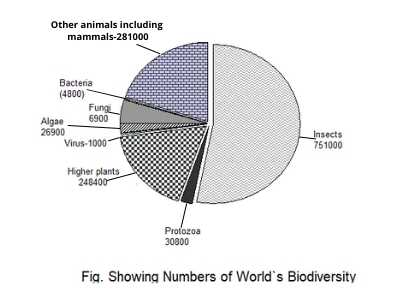According to E.O. Wilson, there are 1.7 million species in the world. At present, this number is considered a small part of the world’s biodiversity. There are 751,000 species of insects known worldwide, including 112,000 species of Lepidoptera, 103,000 species of Hymenoptera, and 290,000 species of Coleoptera. There are also 290,000 beetle species. On the other hand, there are 4,000 or more mammal species. There are currently 4,800 species of bacteria, 69,000 species of fungi, 26,900 species of algae, 1,000 species of viruses, 30,700 species of protozoa, and 281,000 other species, including mammals, in the world. There are 248,400 species of plants except for algae. Following figure shows the number of world biodiversity (source: The Diversity of Life, E.O. Wilson 2006), and Table-1 showing the number of living species of prime vertebrates.
Table-1: Number of living species of prime vertebrates.
| Animal Groups | Number of Species |
|---|---|
| Mammals | 5,000 |
| Birds | 8,600 |
| Reptiles | 8,000 |
| Amphibians | 4,700 |
| Fishes | 28,400 (51.9% of all vertebrates) |
| Total | 54,700 |
Fishes occupy a variety of habitats due to their vast number of species. The number of bony fish species is 26,300, but they are more numerous than other vertebrates. Of all fish species, less than 41.2% or more live in freshwater and 56.2% in saltwater. From an ecological point of view, fish can be divided into the following eight groups based on the main habitat:
Primary Freshwater Fishes
These types of fish cannot live in saltwater. The number of these species is about 9036 which is 33.1% of the total species, of which 8,494 species (94%) belong to the class Cypriniformes and Siluriformes.
Secondary Freshwater Fishes
These types of fish live mainly in freshwater but can live in saltwater at any stage of their life cycle. There are about 2210 species (8.1%) that belong to this group. Most of the fish belong to the family Cichlidae, Cyprinodontidae, and Poeciliidae.
Diadromous Fishes
One part of the life history of these species of fish is spent in freshwater and the other part in saltwater. About 160 species (0.6%) of fish belong to this group, including Catadromous eel, Anadromous salmonids, and galaxiids.
Fishes of Warm Water Littoral and Continental Shelf Region
These types of fish live in areas up to a depth of 200 meters. The number of fish species is about 10890 (39.9%). Perciformes are the main fish of this group (which is the largest group of acanthopterygian fish), especially percoids, blenniods, and gobioids. Anguilliformes (eels) are also predominant among the major non-Perciformes fish.
Fishes of Cold Water Littoral and Continental Shelf Region
They live in areas up to a depth of 200 meters. There are about 1530 species (5.6%) in this group. Notable fish are gaddids (cods, hakes, etc), zoarcids, cold water blennioids, and scorpiniforms (rockfish, sculpins, poachers, etc).
Fishes of Continental Slope and Deep Sea Benthic Region
The area is located below at a depth of 200 meters. About 1650 species of fish (7.4%) live in this area. Notable fish are Macrourids (rattails, grenadiers), brotulids, zoarcids, Anguilliformes, and Scorpaeniforms.
Epipelagic Fishes
Fishes of this group live 200 meters above sea level. There are about 355 species (1.3%) available in this group. Notable fish are Scombroids (tuna, mackerels) and exocitids (flying fish: Exocoetus volitans).
Deep Pelagic Fishes
Fishes of this group live below 200 meters. Mesopelagic and Bethiopalagic sub-regions belong to this region. There are 1365 fish species (5%) that live in this region. The main fishes are stomiiforms, myctophiforms and deep-sea anglerfishes.



